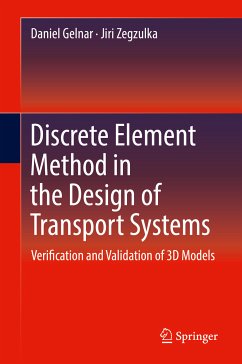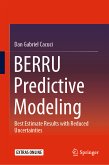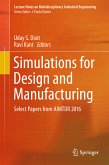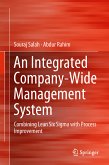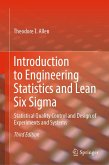Daniel Gelnar, Jiri Zegzulka
Discrete Element Method in the Design of Transport Systems (eBook, PDF)
Verification and Validation of 3D Models
72,95 €
72,95 €
inkl. MwSt.
Sofort per Download lieferbar

36 °P sammeln
72,95 €
Als Download kaufen

72,95 €
inkl. MwSt.
Sofort per Download lieferbar

36 °P sammeln
Jetzt verschenken
Alle Infos zum eBook verschenken
72,95 €
inkl. MwSt.
Sofort per Download lieferbar
Alle Infos zum eBook verschenken

36 °P sammeln
Daniel Gelnar, Jiri Zegzulka
Discrete Element Method in the Design of Transport Systems (eBook, PDF)
Verification and Validation of 3D Models
- Format: PDF
- Merkliste
- Auf die Merkliste
- Bewerten Bewerten
- Teilen
- Produkt teilen
- Produkterinnerung
- Produkterinnerung

Bitte loggen Sie sich zunächst in Ihr Kundenkonto ein oder registrieren Sie sich bei
bücher.de, um das eBook-Abo tolino select nutzen zu können.
Hier können Sie sich einloggen
Hier können Sie sich einloggen
Sie sind bereits eingeloggt. Klicken Sie auf 2. tolino select Abo, um fortzufahren.

Bitte loggen Sie sich zunächst in Ihr Kundenkonto ein oder registrieren Sie sich bei bücher.de, um das eBook-Abo tolino select nutzen zu können.
- Geräte: PC
- ohne Kopierschutz
- eBook Hilfe
- Größe: 30.17MB
Andere Kunden interessierten sich auch für
![Research into Design for a Connected World (eBook, PDF) Research into Design for a Connected World (eBook, PDF)]() Research into Design for a Connected World (eBook, PDF)232,95 €
Research into Design for a Connected World (eBook, PDF)232,95 €![Fundamentals of Optimization (eBook, PDF) Fundamentals of Optimization (eBook, PDF)]() Mark FrenchFundamentals of Optimization (eBook, PDF)46,95 €
Mark FrenchFundamentals of Optimization (eBook, PDF)46,95 €![BERRU Predictive Modeling (eBook, PDF) BERRU Predictive Modeling (eBook, PDF)]() Dan Gabriel CacuciBERRU Predictive Modeling (eBook, PDF)128,95 €
Dan Gabriel CacuciBERRU Predictive Modeling (eBook, PDF)128,95 €![System Dependability Evaluation Including S-dependency and Uncertainty (eBook, PDF) System Dependability Evaluation Including S-dependency and Uncertainty (eBook, PDF)]() Hans-Dieter KochsSystem Dependability Evaluation Including S-dependency and Uncertainty (eBook, PDF)72,95 €
Hans-Dieter KochsSystem Dependability Evaluation Including S-dependency and Uncertainty (eBook, PDF)72,95 €![Simulations for Design and Manufacturing (eBook, PDF) Simulations for Design and Manufacturing (eBook, PDF)]() Simulations for Design and Manufacturing (eBook, PDF)112,95 €
Simulations for Design and Manufacturing (eBook, PDF)112,95 €![An Integrated Company-Wide Management System (eBook, PDF) An Integrated Company-Wide Management System (eBook, PDF)]() Souraj SalahAn Integrated Company-Wide Management System (eBook, PDF)72,95 €
Souraj SalahAn Integrated Company-Wide Management System (eBook, PDF)72,95 €![Introduction to Engineering Statistics and Lean Six Sigma (eBook, PDF) Introduction to Engineering Statistics and Lean Six Sigma (eBook, PDF)]() Theodore T. AllenIntroduction to Engineering Statistics and Lean Six Sigma (eBook, PDF)88,95 €
Theodore T. AllenIntroduction to Engineering Statistics and Lean Six Sigma (eBook, PDF)88,95 €-
-
-
Produktdetails
- Verlag: Springer International Publishing
- Seitenzahl: 208
- Erscheinungstermin: 2. Januar 2019
- Englisch
- ISBN-13: 9783030057138
- Artikelnr.: 58942223
Dieser Download kann aus rechtlichen Gründen nur mit Rechnungsadresse in A, B, BG, CY, CZ, D, DK, EW, E, FIN, F, GR, HR, H, IRL, I, LT, L, LR, M, NL, PL, P, R, S, SLO, SK ausgeliefert werden.
- Herstellerkennzeichnung Die Herstellerinformationen sind derzeit nicht verfügbar.
Ing. Daniel Gelnar Ph.D. received his doctoral degree in 2016 from Vysoká Skola bánská, The Technical University of Ostrava, in the Czech Republic. His research concerns deals with the design and optimization of the bucket elevator using the discrete element method (DEM).
Prof. Ing. Jirí Zegzulka CSc. received his Ph.D. in 1993 from Vysoká Skola bánská, The Technical University of Ostrava in the Czech Republic, Faculty of Mechanical Engineering, Field - Design and Process Engineering. In 2004 he became full professor and, in 2010, joined the ENET Centre (Energy Units for Utilization of non-Traditional Energy Sources) as senior researcher. The research in his group is focused on development of transport equipment for bulk materials, measuring of physical and mechanical properties of powders and DEM modelling. He is member of European Federation of Chemical Engineering (EFCE), Mechanics of Particulate Solids and Czech Science Foundation.
Prof. Ing. Jirí Zegzulka CSc. received his Ph.D. in 1993 from Vysoká Skola bánská, The Technical University of Ostrava in the Czech Republic, Faculty of Mechanical Engineering, Field - Design and Process Engineering. In 2004 he became full professor and, in 2010, joined the ENET Centre (Energy Units for Utilization of non-Traditional Energy Sources) as senior researcher. The research in his group is focused on development of transport equipment for bulk materials, measuring of physical and mechanical properties of powders and DEM modelling. He is member of European Federation of Chemical Engineering (EFCE), Mechanics of Particulate Solids and Czech Science Foundation.
Chapter 1. Introduction.- Chapter 2. Basic description of DEM.- Chapter 3.Basic description of bucket elevators.- Chapter 4.Bucket elevator filling and discharge.- Chapter 5. The new method of design and optimization.- Chapter 6.Input parameters for DEM - bulk material.- Chapter 7.Input parameters for DEM - geometry of the 3D model and validation machine.- Chapter 8. Input parameters - kinematic properties.- Chapter 9. Process validation and calibration.- Chapter 10. The results for the optimization of bucket filling and discharge.- Chapter 11. The results for optimization of filling bulk material in the bucket to minimize travel resistance and impacts.- Chapter 12. The results for process optimization of bulk material filling into the bucket to minimize abrasive and destructive impacts of the bucket edge on the transported mass.- Chapter 13. The optimization of bucket discharge to maximize the transported volume and to minimize material fall down the shaft.- Chapter 14. Conclusion.
Chapter 1. Introduction.- Chapter 2. Basic description of DEM.- Chapter 3.Basic description of bucket elevators.- Chapter 4.Bucket elevator filling and discharge.- Chapter 5. The new method of design and optimization.- Chapter 6.Input parameters for DEM - bulk material.- Chapter 7.Input parameters for DEM - geometry of the 3D model and validation machine.- Chapter 8. Input parameters - kinematic properties.- Chapter 9. Process validation and calibration.- Chapter 10. The results for the optimization of bucket filling and discharge.- Chapter 11. The results for optimization of filling bulk material in the bucket to minimize travel resistance and impacts.- Chapter 12. The results for process optimization of bulk material filling into the bucket to minimize abrasive and destructive impacts of the bucket edge on the transported mass.- Chapter 13. The optimization of bucket discharge to maximize the transported volume and to minimize material fall down the shaft.- Chapter 14. Conclusion.
